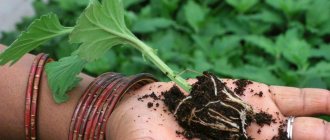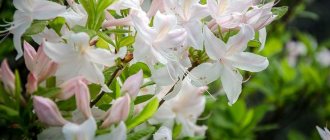Author: Elena N. https://floristics.info/ru/index.php?option=com_contact&view=contact&id=19 Category: Garden plants Published: January 26, 2019Last edits: January 20, 2021
- Soil preparation
- How to care
- Wood mallow (Malva sylvestris)
- Musk mallow (Malva moschata)
It's drizzling endlessly. Only the hollyhocks shine, as if there is a cloudless day above them. Basho
Malva is a beauty that you can’t hide behind a fence! And why? After all, this is definitely not why breeders worked so hard on flowers of jewelery beauty in all possible shades: from virgin white to blue-black! Did you know that the closest relatives of mallow are kalachiki (wortwort) and marshmallow? From the first, the hollyhock inherited unpretentiousness and pretty rounded leaves, and from the second – many healing and even magical properties! It is believed that mallow planted along the fence protects the house and all its inhabitants from the evil eye and evil. But it turns out that not all hollyhocks will do well near any fence... How to please a hollyhock so that it blooms for 4 months in a row, read on.
Planting and caring for mallow
- Planting: sowing seeds in May-June in open ground or in January-February for seedlings (planting seedlings in the ground - in mid-May).
- Flowering: mid-summer.
- Lighting: bright sunlight, light partial shade.
- Soil: rich in humus, well-drained, average moisture, neutral.
- Watering: moderate to abundant, regular.
- Garter: recommended, especially for tall varieties.
- Fertilizing: before budding with complex mineral fertilizer with a predominance of nitrogen.
- Reproduction: seed.
- Pests: slugs.
- Diseases: rust, powdery mildew.
Read more about growing mallow below.
Mallow (lat. Malva) , or mallow , or kalachik , or hollyhock , is a type genus of the Malvaceae family - a herbaceous plant, usually annual, sometimes biennial and perennial. Today, about 30 species of mallow grow naturally in the temperate climates of North Africa, North America, Asia and Europe. Mallow was cultivated in Ancient Egypt and Ancient Greece: a description of the healing properties of the plant was found in the works of Hippocrates and Pliny the Elder. In the twenties of the last century, scientists discovered ecological plasticity and high feeding qualities in mallow. And large bright pink flowers have always aroused the admiration of artists who depicted them in paintings and poets who sang them in poetry. And how can one imagine a Ukrainian hut without a mallow growing next to it in the front garden? Or a Ukrainian towel without its bright pink flowers...
Features of garden care
How to care for mallow
It is very easy to grow mallow, as it does not have a capricious character. It must be regularly watered moderately, especially if the summer period is quite dry. The soil surface must be loosened in a timely manner, and weeds and fading flowers must be removed. Before the budding period begins, experts advise feeding plants with mineral fertilizers, which contain large amounts of nitrogen. Tall varieties require a mandatory garter, as the stems can be injured in the event of strong winds. To do this, it is recommended to plant the plants in close proximity to the fence (use it as a support), and you can also place a high peg next to each bush and tie the mallow to it. If you want your annual mallow to grow like a perennial one, then when it fades, all flower stalks should be removed from the stems. It is important to do this before setting seeds.
Pests and diseases
Slugs can live on such flowers. They are destroyed using special traps. To do this, you need to place several plates in the area with flowers and fill them with beer. After about 24 hours, you will need to check these traps and remove all slugs. This plant is quite resistant to diseases, but if it is planted near a metal fence, the mallow is quite capable of becoming infected with rust. It is very easy to find out about infection; dark red spots can be seen on the underside of the leaf blades. Infected foliage should be trimmed and destroyed. In rare cases, powdery mildew infection may occur. To get rid of it, use an appropriate fungicidal agent or a solution of colloidal sulfur.
Care after flowering
In autumn, after flowering has ended, the shoots need to be cut to the level of the ground surface. At the same time, you can enrich the soil with nutrients; to do this, its surface must be covered with a layer of mulch (compost and humus). So, for 1 square meter you will need about 3-4 kilograms of mulch. For wintering, such a plant should be covered with dried leaves, spruce branches or straw.
Botanical description
The most famous and ancient representative of the genus woodland mallow is a plant with a straight, recumbent or ascending stem 30-120 cm high, at first fluffy and hairy, and then bare. The leaves of the mallow are heart-shaped, round, notched or five-seven-lobed, pubescent, petiolate. Large, up to 12 cm in diameter, flowers in the shape of a wide bell with characteristic purple stripes of 1-5 pieces are hidden in the axils of the leaves. In some species, the inflorescences form racemes.
Mallow blooms from June to August, it is frost-resistant, drought-resistant and easy to care for.
- Gardening work in November - 9 points that will preserve your garden until spring
Depending on the variety, single or double flowers vary in color from almost black to white. Petals are oblong, obovate, deeply notched. The mallow root is spindle-shaped, branched, and long. The fruit is polyspermous; the seeds remain viable for 2-3 years.
Reproduction
Planting from cuttings ensures that our plants will have the exact characteristics of the desired variety. When planting cuttings in the spring in the root area, it is necessary to take cuttings from an adult plant. And in the summer, stem cuttings are cut for such planting.
They are cut with a knife, and the cut is treated with charcoal. The cuttings are left for several hours so that the wound dries a little. Then the resulting cuttings are planted in pots with nutritious soil, do not forget to water them regularly. The new leaves that have appeared will tell you about normal rooting.
The grown cuttings are planted in a permanent place. Experienced gardeners use this method, because the survival rate of cuttings is very low.
To grow mallow, they use the seedling method; the sooner you plant it, the faster the plant will bloom for the first time. But when planting early, it is better to highlight the plant additionally.
Sowing of seeds begins in March-April. The grown seedlings are planted in a permanent place on the site. The time for planting seedlings is in June or July. It rarely happens that a plant will bloom in the first year.
Growing mallow from seeds
Growing conditions
If you don’t want to make extra efforts and are in no hurry to see the mallow blooming this year, you can sow the seeds directly into the ground in May or June. But then your mallow will only have time to form a rosette of leaves before the onset of winter, and will bloom only next year. If you want the mallow to bloom this summer, you should sow seeds for seedlings in January-February.
But even if you are ready to grow mallow as a biennial or perennial plant, the seedling method is still more reliable than the seed method.
For both annual and perennial mallow, this process is the same, the only difference is when to sow. Annual mallow is sown in mid-winter, planted in the ground in May, and blooms in mid-summer. Biennial and perennial mallow is sown in May and planted in the ground in August or September.
Growing seedlings
It is advisable to soak mallow seeds that you have stored for a year or two or purchased at a flower shop for 12 hours in warm (45 ºC) water before planting in order to soften the hard seed shell and facilitate the germination process.
It must be said that mallow seeds, which remain viable for up to three years, germinate much better in the third year of storage than in the first two years.
To sow mallow for seedlings, it is better to use peat pots, since the roots of the mallow do not tolerate transplantation well and often do not take root in a new place. The temperature for seed germination should be 18-22 ºC, then seedlings will appear in two weeks. If you sowed mallow in a container, then after three leaves appear on the seedlings, you will have to thin them out so that there is a distance of 2-3 cm between the seedlings. The removed sprouts can be saved by carefully planting them in peat pots. When the seedlings grow and become stronger, they need to be hardened off by placing them in fresh, cool air for several hours. In May-June, seedlings can be planted in the ground directly in pots.
In the photo: Growing mallow seedlings from seeds
Problems and solution
Difficulties with mallow rarely arise, but no one is immune from them, so novice gardeners often worry that something is wrong with the plant.
| Problem | Cause |
| The leaves turn yellow and dry out. | Possible reasons:
If the problem is a disease, then it is necessary to spray the flower with colloidal sulfur, copper oxychloride, Bordeaux mixture or any fungicide. Excessive or insufficient watering is corrected on site. |
| The tips of the leaves turned white and curled, and then withered. The plant itself grows poorly and practically does not bloom. | Lack of calcium in the soil. |
| The leaves become pale green (until a bluish tint appears), the edges turn brown and curl. | Not enough potassium. |
| The mallow has vigorous foliage but has not bloomed. | Remember, haven’t you gone too far with nitrogenous fertilizers, which contribute to the growth of green mass to the detriment of flowering? The second reason is that most varieties do not bloom in the first year, especially if they were grown from seeds using the seedless method. |
| Poor growth, poor and faded flowering. | Most likely, the mallow does not have enough sun. When planting it, shaded areas should be avoided. |
Planting mallow
Soil preparation
Choose a sunny area in the garden (mallow grows in partial shade, but loses its bright color and stem height) with good drainage and loose loamy, humus-rich soil. The place for sowing should be high to prevent rotting of the roots from standing melt water. It would be nice if the area was protected from winds and drafts. It is best to plant mallow along the fence: there will be a support nearby to which you can tie the stems. If your soil is poor, you will have to fertilize it by mulching the area with humus. But more on that later.
How to plant in the garden
Seedlings of annual mallow are planted in open ground in mid-May. Seedlings of two-year or perennial mallow are planted in the ground in August-September. Seeds of biennial and perennial mallow can be sown directly into the ground. This is done in the spring, in April-May, after late frosts. Small holes are made in the soil up to 3 cm deep and 2-3 seeds are placed in each hole.
Depending on what variety of mallow you are planting, the distance between seedlings should be from 25 cm to 50 cm.
The hole is filled in, the soil is pressed down and moistened. If you are not sure that summer has finally arrived, place covering material on your bed so that the sprouts are not damaged by possible frosts. Under favorable weather conditions, the seedlings will hatch in two weeks. When the seedlings have 3-4 leaves, they need to be thinned out, leaving one tall seedling in the hole.
Planting hibiscus in the garden - all the information you need
Site selection
Double mallow flowers take root better if they are planted immediately in a permanent place where they will continue to grow in the future. Therefore, it is important to immediately select a suitable site. Perennial mallow loves open areas, sufficiently illuminated by the sun. In shady places, its stems stretch towards the light and become thin and weak. Lack of light also reduces its flowering. The delicate petals and tall stems of terry mallow are easily damaged by the wind, so the area should be protected from drafts. Flowers grow well in light, fertile soils with good drainage - loam is ideal. At the same time, perennial mallow thrives in poor soils if you feed it regularly.
When preparing a site for planting terry mallow, the following measures are necessary:
- deep digging of the soil;
- on problem soils, the addition of compost is required; it can be replaced with rotted manure;
- The drainage properties of the soil can be improved by adding coarse sand.
Mallow care
How to care
Growing mallow is a simple process, since mallow is not a fussy plant. Regular moderate watering, especially in dry summers, loosening the soil and weeding, timely removal of wilted flowers are mandatory requirements for caring for mallow.
- Broom: growing in the garden, types and varieties
In addition, it would be good to feed the plant before budding with mineral fertilizers with a predominance of nitrogen.
A tall mallow needs staking to prevent it from breaking under strong gusts of wind, so plant it along the fence or dig in high pegs to secure the plant. Well, if you want to make a perennial from an annual, immediately after the mallow has bloomed, cut off all the flower stalks so that the seeds do not have time to set. That's all for caring for mallow.
In the photo: Mallow flowering in the garden
Diseases and pests
Mallow is attacked by slugs. They are collected by hand: place small bowls in different places, pour beer into them, and after a day, walk around and collect the slugs that come crawling to get drunk.
Of the few diseases that affect mallow, the worst is rust, which can easily be contracted near metal fences. The disease manifests itself in the appearance of dark red spots on the back of the leaves. Affected leaves should be removed and burned.
Sometimes powdery mildew appears on mallow. You can fight it with a solution of colloidal sulfur or a specialized fungicide.
In the photo: Pests of mallow on a flower
Mallow after flowering
In the fall, after the mallow has bloomed, the stems are cut down to ground level. At the same time, you can fertilize the soil by mulching it with humus and compost at the rate of 3-4 kg per 1 m2. Mallow should overwinter under cover of spruce branches, fallen leaves or straw.
In the photo: Mallow has bloomed
Diseases and pests
Photo: https://pixabay.com/photos/stock-rose-dark-pink-alcea-rosea-3477656/
Mallow has strong immunity and is practically not susceptible to diseases, and pests often avoid it. But there are times when this strong plant begins to wither.
With excessive watering, mallow suffers from fungal infections, in particular rust or powdery mildew. You can get rid of them by spraying with fungicidal preparations or colloidal sulfur. Most likely, several treatments will be needed.
Of the parasitic insects, mallow can be attacked by:
- spider mite, which settles on the “wrong side” of the leaf and feeds on its sap;
- aphids that prefer the sweet juice of unopened buds.
You can get rid of these pests using traditional methods. The most popular is spraying with a strong soap solution made from hot water and brown laundry soap. Flowers must be sprayed in the morning or after sunset, and then repeat the procedure several times with an interval of 3-5 days.
If the number of insects is large and a soap solution does not help, then you can use insecticides that are sold in specialized flower shops. By following the instructions, you will not only get rid of parasites, but also limit their spread to other plants.
The healing properties of mallow
Mallow has long been known in folk medicine. The beneficial properties of mallow have been studied by healers in many countries. For example, an infusion of mallow flowers and leaves treats inflammation of the stomach and intestinal disorders. Hot baths with steamed leaves or flowers of mallow (wood mallow) help relieve swelling of the spleen. The wild mallow herb is a constant component of breast collections.
Lavatera: planting and caring - a relative of mallow
In the form of lotions and compresses, a decoction of mallow flowers is used for skin diseases to relieve itching and to heal wounds (obviously, due to the mucus contained in mallow). Mallow is also used in medical cosmetology to restore the epidermis and prevent pustular rashes. Preference in folk medicine is given to mallow flowers, since they contain higher levels of sugars, vitamin C and carotene than the leaves. The main thing is that preparations from mallow do not give unwanted side effects and have no contraindications.
Beneficial properties of mallow:
- expectorant;
- emollient;
- reparative;
- enveloping;
- anti-inflammatory;
- restorative.
Mallow tea for coughs: pour 2 teaspoons of finely chopped flowers (or leaves) into a glass of boiling water and leave for 10 minutes, strain, drink 2-3 cups a day. You can add honey, but then the tea should be no warmer than 40 ºC.
… Every year in May, Kyoto’s Kamigamo Temple and the city host the Aoi Matsuri festival, dedicated to mallow. People put on bright clothes and walk through the streets of the city dancing and singing. This holiday is many centuries old...
The May rain is endless... The hollyhocks are reaching somewhere, Looking for the path of the sun. Basho
Types and varieties of mallow
The genus mallow in cultivation includes about 60 species of ornamental plants. The ancestor of this genus, woodland mallow, is an annual plant. And species such as Sudanese mallow, hybrid, musky and wrinkled are predominantly perennials. True, it must be said that not all flower growers include all these species in the mallow genus, considering, for example, that the Sudanese mallow, or hibiscus, as well as the wrinkled mallow, or rose hollyhock, although they belong to the mallow family, are related to to another kind. Let’s not quibble: the plants are so similar in characteristics that it makes sense to combine them into one section on care and cultivation.
Mallow annual
Wood mallow (Malva sylvestris)
So, forest mallow , or Kalachiki . This biennial plant is grown in our country as an annual one. It grows up to 120 cm, its flowers are characterized by the presence of darker veins than the color of the flower. Popular varieties are mallow zebrina, characterized by large flowers of soft pink color with dark red veins. The Black Mother of Pearl variety is also in demand - dark purple flowers up to 7 cm in diameter with black veins.
In the photo: Wood mallow or kalachiki
Mallow in landscape design
Mallow is ideal for planting near fences or walls of the house. Also, tall varieties can be used to decorate an unsightly structure or cover communications. Mallow plantings are used to divide a flower bed or vegetable garden into separate sections.
Mallow in landscape design
The plant is actively used to create the background of a flower arrangement. Smaller crops are planted in front. Landscape designers, choosing plants of various colors and sizes, create an interesting combination of several shades of a multi-level composition.
On a note! Mallow is indispensable when creating a flowerbed in a rustic style.
Stockrose goes well with delphiniums, daisies, phlox, and cornflower. Mallow of discreet shades harmonizes with herbs and cereals. Terry varieties of mallow look original and elegant.
perennial mallow
Musk mallow (Malva moschata)
It is a low perennial - no higher than a meter. The fragrant flowers of white or pink musk mallow reach a diameter of 5 cm. This mallow is sometimes called nutmeg mallow. Popular varieties are White Tower and Pink Tower, 70cm tall with snow-white or hot pink flowers respectively. These varieties bloom until frost.
- Stratification and scarification of seeds - which plants need them and how to carry them out correctly?
In the photo: Musk or nutmeg mallow
Sudanese mallow
Or Hibiscus Sabdariffa , or Sudanese rose - a biennial plant grown for its fruits, which have long been one of the components of fruit drinks that have medicinal value. The known bush form is Malva sabdariffa var. Sabdariffa and the tree form Malva sabdariffa var. Altissima.
In the photo: Sudanese mallow or hibiscus sabdariffa or Sudanese rose
Wrinkled mallow (Malva rugosa)
Rose stock , or wrinkled alcea - it is conventionally called mallow. The plant in nature reaches two meters in height, its flowers are 3 cm in diameter, yellow. It is a perennial. Garden form - pink hollyhock, or rose hollyhock (Malva alcea). The plant is a perennial, reaches 90 cm in height. It has varieties with both simple and semi-double and double flowers, similar to peonies.
For example, the Chater's Double Strein variety is a double mallow with large flowers of different colors, while Single Mixed has simple flowers reminiscent of hibiscus. Stock rose varieties also differ in size: the Powder Puffs Mixed variety, for example, reaches a height of two meters, and Majorette Mixed is a dwarf plant (up to 75 cm), but with large semi-double flowers.
In the photo: Rose hollyhock or rugose mallow or rugosa alcea
Hybrid mallow (Malva hybrida)
It is a perennial with several stems, height up to 2 m. The flowers are white or pink, double, very large. Blooms in June-September. Popular varieties: Chaters Double, Gibbortello, Powder Puffs.
In the photo: Hybrid mallow
You should know that almost all varieties of forest mallow are annuals, and varieties of other types of mallow are mainly biennials or perennials, but this division is arbitrary: both among the varieties of forest mallow there are perennial varieties, and among the conventional perennials there are annual varieties.
Watering
The frequency of watering varies greatly depending on weather conditions and climate. In southern regions with rare rains, it is necessary to moisten the soil on average twice a week in the amount of 4-5 liters for each adult bush. Watering in the middle zone may be necessary literally 1-2 times a month.
Water is added as the top layer of soil dries. During the period of bud formation and flowering, the frequency and intensity of watering is slightly increased. Do the same with young plant specimens.
Fertilizer application
For most of the year, mallow prefers exclusively organic feeding with peat, humus or compost. The optimal dosage of fertilizers is 3 kg per square meter of planting.
Before flowering begins, it is also advisable to add inorganic universal mineral complexes. It is recommended to dilute them with water for irrigation in an amount of 30-40 g or ml per square meter of mallow plantings.
Care after flowering
To extend the overall flowering period of the entire plant, the flower stalks are cut off as soon as the petals fall from them. By winter, the shoots are shortened to the root.
During cold weather in the southern regions, mallow is mulched with humus, less often with sawdust. In northern climates, in addition to mulch, a denser cover is needed, for example, spruce branches. It is advisable to thoroughly insulate young mallow specimens in the first couple of years of life for the winter by adding another layer of dry leaves.
Plant treatment
The most common natural enemies of mallow are fungal diseases. They are usually caused by overwatering and dampness in the air. In such a situation, it is necessary to cut off the affected fragments of the plant, reduce watering and treat it with fungicides to destroy fungal spores.
Among insects, aphids and spider mites relatively often settle on mallow. They also need to be combated with specialized preparations - insecticides. It’s better not to try traditional recipes; they are much less effective.
Additional care measures
- The plant can reach 2 meters in height, which is a large load for a herbaceous stem. Therefore, it is recommended to tie adult mallow specimens to wooden supports so that the stems do not break.
- The mallow root system needs a regular supply of air for breathing. To ensure ventilation, as well as to prevent the appearance of weeds, the soil around the plant must be loosened regularly.
- Inspect the mallow regularly and cut off any dried, rotting or severely damaged pieces. This will achieve optimal distribution of the plant’s vitality and improve the duration and intensity of flowering.











